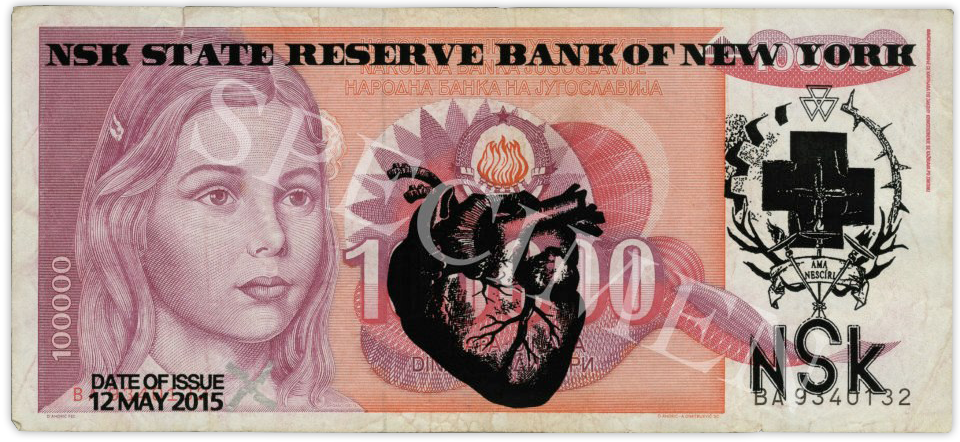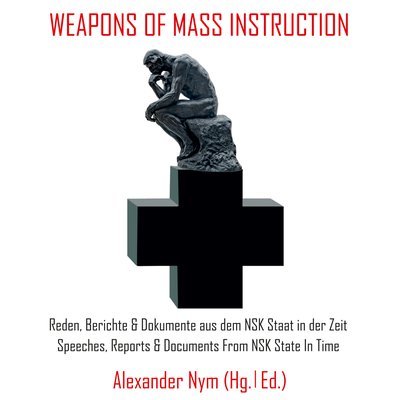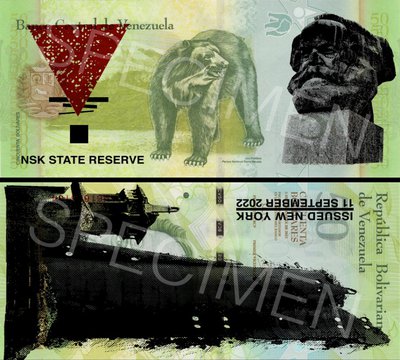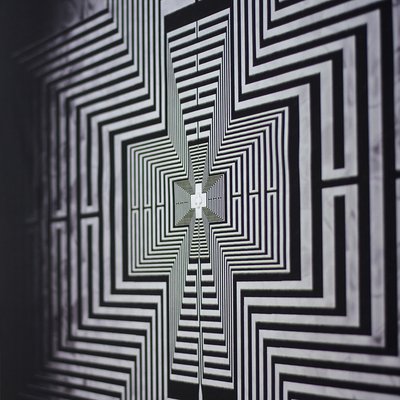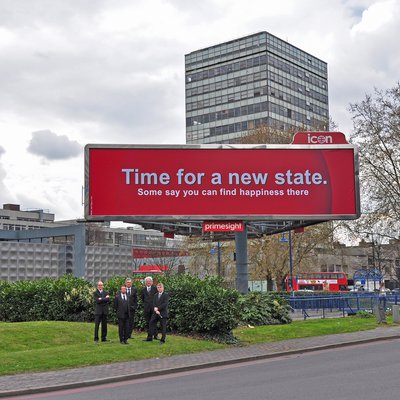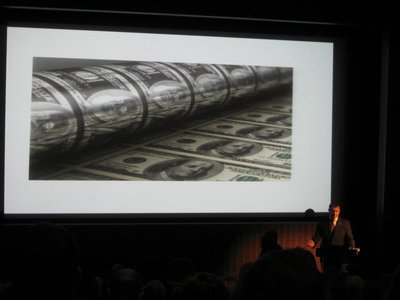On May 12, 2015, an event was held to mark the opening of the NSK: Kapital to Capital exhibition at the Moderna Galerija in Ljubljana, a retrospective of the first ten years of the artist meta-collective, NSK. The end of this period coincided with the end of Yugoslavia and the beginning of the NSK State – a virtual state, complete with passports, which they created. At the event on May 12th members of one of the constituent collectives, Irwin, handed out envelopes marked “N$K”, with a dollar sign. Simultaneously, thousands of miles away in New York, Laibach, one of the other original NSK groups, held a concert where these envelopes were also distributed. Both sets of envelopes contained a new state artifact: NSK State currency.
Currency has an intangible requirement. No matter how skillfully crafted the notes are, it only becomes currency when enough people believe that it is. This is the same requirement that must be met for a state and all of its institutions, processes, and documents to come into being. The NSK State’s founding artifact, the passport, also asks us for this intangible element, and by asking it challenges the state, and the notion of what is “official”, as a consensual illusion. Can just anyone print passports? Or money?
NSK State currency moves along this axis of inquiry. Unlike passports, money cannot be used as a tool of interrogation for our individual identities. A currency note does not reflect individuality or display affinity for a particular person. It can pass hand to hand, unchanged, without a ripple or a memory. Our currency is not a reflection of us, it is an independent state actor which uses the state and its citizens as a system of transport and protection. It is a parasite. We claim to own it, but it may have other ideas.
Like any good parasite, currency provides its host with some benefits. The most obvious is both well known and popular – currency provides the capacity to exchange for goods and services with other, similarly infected participants within its system. This benefit is not immediately available to holders of our nascent currency. The necessary shared illusion does not yet exist around it. There is no fine-grained notion of appropriate or required usage.
There is, however, a less obvious benefit which we may benefit from immediately. Currency, by passing from hand to hand, makes a tangible connection when the transfer takes place. Whatever network connects the bestower and recipient of the currency is made material as it travels from one to the other. In the case of NSK State currency, the NSK State is itself manifested in this circulation, in much the way that it is manifested in its embassies and passport offices. This effect, this stimulation of a living network of hosts, is what we most strive for in this currency’s creation and distribution.
To encourage this circulation we leverage the economic mechanism of inflation. A reader who has experienced inflation first-hand will most likely consider it a bad thing. Your money becomes less valuable. You have to spend more for the same things. Prices go up. If you’re from America, you might remember it from the 70s, and the attendant recession that followed. If you’re from Yugoslavia you might remember it from the 90s, and the subsequent breakdown of the federation.
In less extreme cases, however, inflation can be useful. By slowly reducing the value of currency, it becomes important to spend rather than hoard it, which encourages circulation and exchange. This dynamic is sufficiently understood and accepted that the code implementing Bitcoin, which has no central bank to manipulate inflationary pressures, automatically creates inflationary pressure by increasing the size of the monetary supply, slowly devaluing the bitcoin already in existence to encourage its use.
This directly stimulates the non-financial benefit of currency described above. As the flow of currency is stimulated, participants in the system will interact more frequently, creating opportunities for them to reinforce their mutual membership through exchanges or even outright gifting. In theory, interaction with other participants in the system should occur more frequently.
To stimulate this effect we experimented with two techniques. Our first approach was to set an expiration date of either one or five years on each note. There is some precedent for this mechanism, although it is not a common practice for currency. Store coupons, for example, often have an expiration date. In our initial distributions we included bills with both one and five year horizons for their expiration, hoping to observe a difference in how they were utilized.
Our second strategy has been to simply flood the ‘market’ with free money, hoping to saturate individual appetite for hoarding currency, or at least sufficiently satisfy it to make further circulation possible. At the events of May 12, 2015 we distributed on the order of 500-600 of the new notes.
Design and Dinars
“A currency is a national business card, so you want to make it right.”
– Ralf Wintergerst, head of banknote production at Giesecke & Devrient GmbH
The first thing people notice about NSK State currency (N$K) is how real it is. This is not surprising. Rather than print money from scratch, we elected to start with the currency of a previously existing, non-virtual state with access to the presses and paper typically used for this purpose and overprint it with our own designs, converting it to currency of the NSK State. This is not without precedent. Occupying forces are frequently called upon to control the economies of the vanquished and even to issue script that can be used under occupation. Sometimes this currency is printed from scratch, such as the Japanese Peso issued by U.S. forces following World War II. Other times the existing currency is kept in circulation but goes through a process of conversion much like the one we applied: it is stamped to declare the state to which it owes its new allegiance.
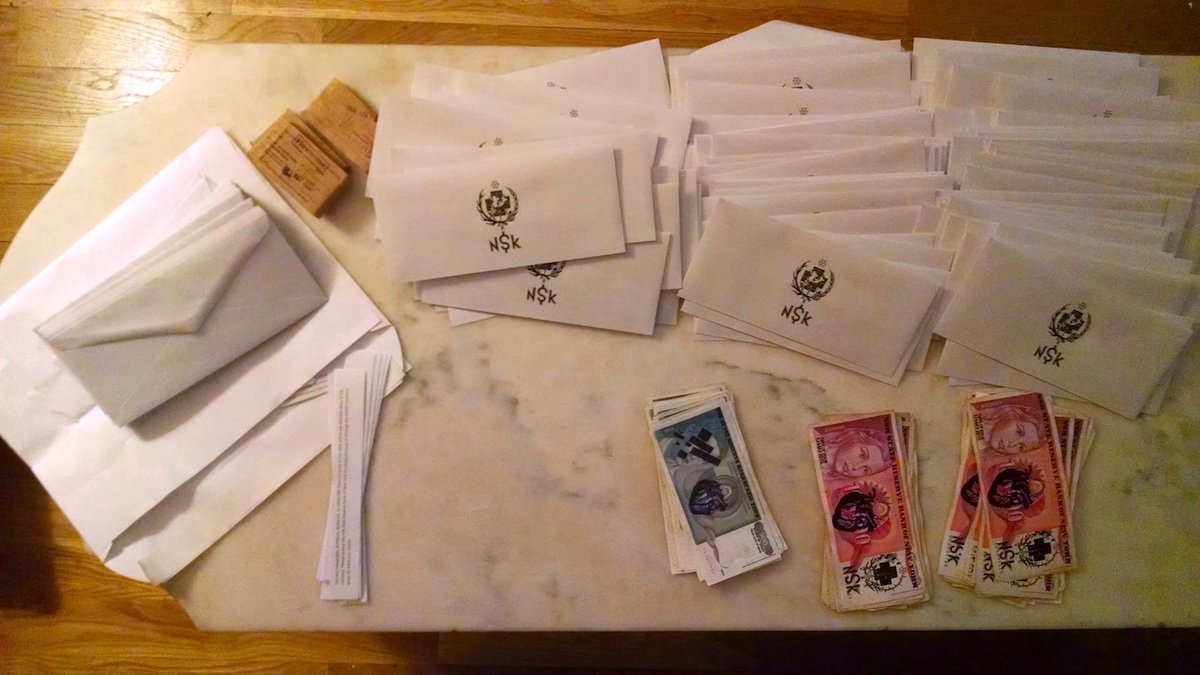
N$K has had several iterations with different base notes and designs. The run of bills created for distribution in May of 2015 used the Yugoslavian dinar as a substrate. Yugoslavia, being the cultural homeland of the NSK State, was an obvious symbolic choice, and also a practical one. It was not difficult to procure the quantities of bills we required due to the abundance of dinars produced during Yugoslavia’s hyperinflationary period. We were caught off guard, however, at the emotional depth this added to the project. We very quickly discovered that anyone who had been around for the dinar’s original appearance was immediately struck by seeing them again and they would often have stories about them. For some the stories were about how dear these bills had been. For others, they were about how worthless. One recipient described how as a girl she had been given a stack of them to use as play money with her dolls. For another person, each of those bills had been a month of school lunches. One recipient considered them a potential incitement to Yugoslavian reunification. The choice of the Yugoslavian dinar added a vivid element of recapitulation to the project.
To convert the dinar to NSK State currency we added the aforementioned expiration date, the date of issue, the NSK seal, a windmill stamp drawn from the Seal of New York City, and attribution to the NSK State Reserve Bank of New York, the entity we created for this purpose. We also added a security stripe, which we will leave to the reader to discover and enjoy. Last and most importantly, an anatomical heart was overprinted on the front of the note. Together with the torch already present on the bills, the overprinted heart creates the sacred heart familiar from Irwin works. This heart, which we have adopted as a recurring symbol on our notes, represents the flow of currency through the state, connecting and nourishing it. This is a key abstraction. Every action we take with these bills has this circulatory notion in mind.
Results
In the initial distribution a short note accompanied the bills asking the recipient to inform us of how they were used. Somewhere in the neighborhood of 300 envelopes were distributed. No responses were received. We have not been able to assess the effectiveness of the expiration date in influencing the behavior of the holders of these notes, and anecdotally it seems that the expiration dates were ignored. Eventually we abandoned this strategy and produced bills that will hold value indefinitely.
We did continue with the strategy of producing a significant money supply. This is a bit of a balancing act, since we would like the bills to be dear enough not to throw away, but common enough to be let go of in a more interesting manner. Since this initial distribution we have staged a number of disbursements in venues ranging from Slovenian state receptions to lower east side variety shows. Bills have been distributed en masse by hand, individually by mail, and sporadically through random encounters. There has also been evidence of indirect distributions: photos of the bills left along with tips in restaurants and bars and sometimes stories from the indirect recipients themselves.
We have noticed that even without a system in which to utilize these bills or a fiscal authority to back them they tend to evoke a positive, if confused, response, even without prior exposure to Yugoslavian dinars or NSK. In part this can be attributed to the aesthetic beauty of the bills themselves, but this also demonstrates that a psychological response to currency can be triggered even in a fiscal vacuum.
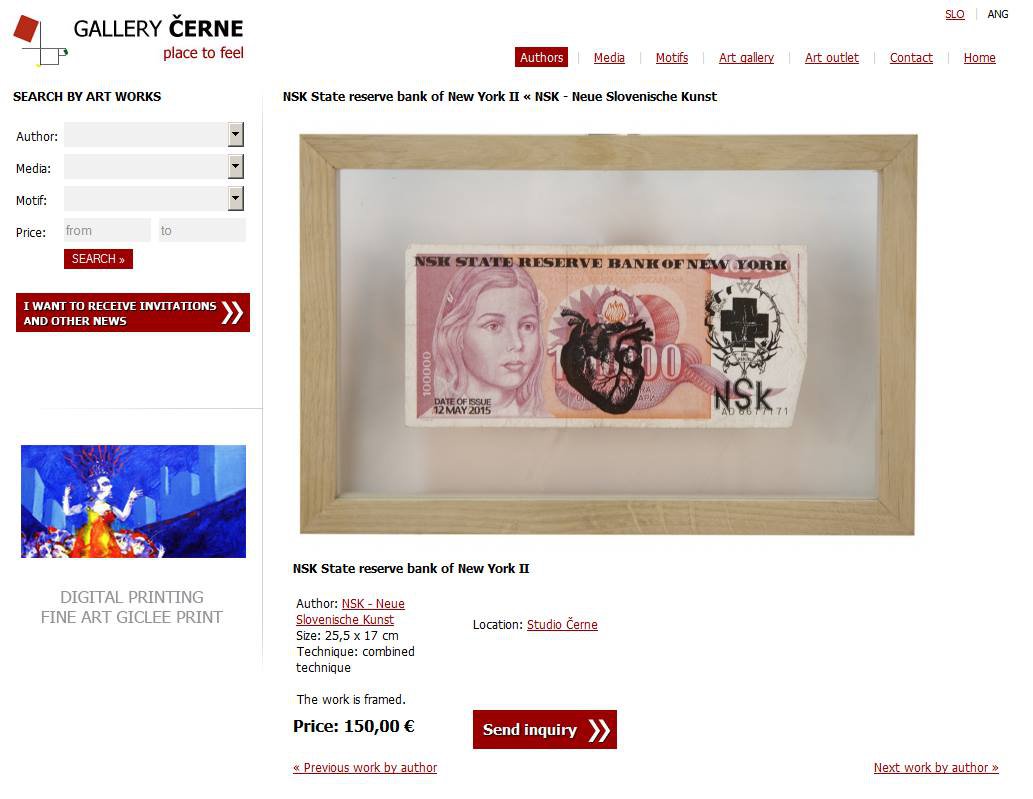
This vacuum, however, is not complete, or may not be for long. While there is no set exchange rate or pricing for the notes, and we have yet to hear of a transaction occurring with them, we have discovered some of the notes from the May 2015 distribution for sale at Studio Černe, an art gallery outside of Ljubljana, under the slightly misleading pretense (or possibly, misunderstanding) that they were created by the NSK collective. While we have not put a price on the notes thus far, someone else has. And if someone someday meets their posted price of €150.00 per note we will have the first data tick on the foreign exchange board for N$K.
Prospectus
The NSK State currency project has been sufficiently well-received for us to continue it into 2016, potentially diversifying into other financial instruments, mediums, and mechanisms. We look forward to seeing state currency travel on its own, both as a means of exchange and as an artistic element, as we believe it has in an instance of Roman Uranjek’s One Cross A Day project which included an original note from the artist Filip Markiewicz (“Sorry”) decorated (occupied) with the NSK sigil. We also hope to improve distribution through the network of the NSK State such that any and all interested citizens will have access to it.
Look for future disbursements at the NSK State embassy or NSK State Reserve Bank of New York office near you.
